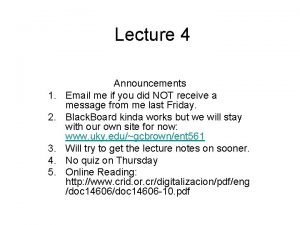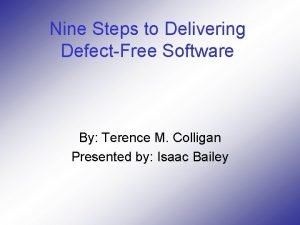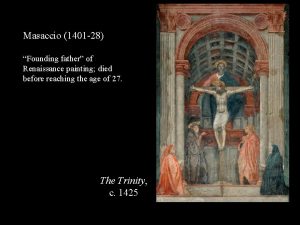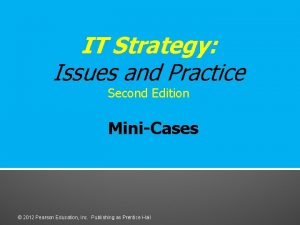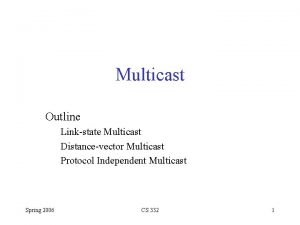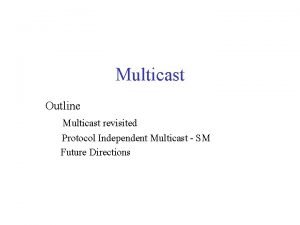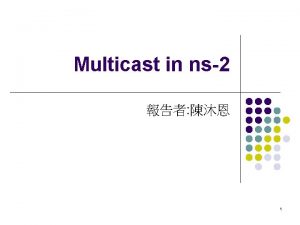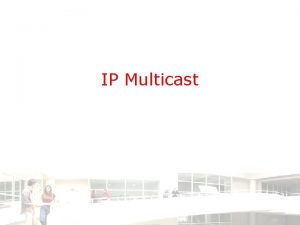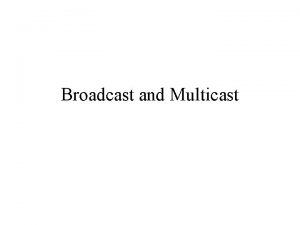Host Multicast A Framework for Delivering Multicast to











- Slides: 11

Host Multicast: A Framework for Delivering Multicast to End Users Jonghak Kim Hyungik Oh Huo Da 1 June, 2002 INFOCOM

Motivation l l Fast increasing need for scalable and efficient group communication Slow deployment of IP Multicast – l Emerging End-host based Multicast – – 2 Deployment imposes dependency on routers Member hosts duplicate and forward packets Easy to deploy, but less efficient

Host Multicast l l l A hybrid approach Goal: Ubiquitous Multicast Design Requirements – Deployable on the current Internet l l – Compatible with IP Multicast to the furthest extent l l – Use IP Multicast where available Provide incentive to future deploy Scalability and Efficiency l 3 No support is required from OS, routers and servers Enable multicast applications Multicast group should not be a limiting factor

Architecture Rendezvous Point (HMRP) RP Designated Member (DM) DM Host IP Multicast Island 4 Host DM Host Unicast Tunnel DM Host Normal Member Host Group Management Protocol (HGMP) for intra-island To A network Each bootstrap member Multicast of new any runs Tree size members our Protocol that daemon supports (HMTP) program IPto. Multicast, atbuild user-space inter-island e. g. single tunnels host, management Ethernet, campus network etc.

Host Multicast Tree Protocol (HMTP) l l Build a bi-directional shared-tree connecting all islands The tree should be congruent to physical network topology to be efficient – l The tree should be robust – 5 use member-to-member round-trip time as distance metric in current design be able to handle node failure, dynamic join/leave etc.

Join Group root HMRP always knows the root of the tree. A B A newcomer does a depth-first search of the tree to find a close member as its parent. C D F E 6 Clustering nearby members makes the tree congruent to physical network topology to the first order. H G Where is my group? Root of your group is A RP

Tree Maintenance l l 7 Each member keeps its children list and root path up to date by exchanging REFRESH and PATH messages with neighbors. Root sends REFRESH message to HMRP. A B C D F E H G RP

Member Leave and Partition Recovery l l Parent deletes the leaving node from children list. Direct Children repair the tree by running join procedure in the reverse order. l 8 If root is leaving, the first node contacting HMRP is assigned as new root. A B C D F E H G RP

Tree Improvement l Periodically re-run the join procedure – – – 9 To accommodate changes in network conditions and group membership Start from a randomly picked node in the root path. Less frequent than REFRESH and PATH messages.

Loop Detection and Resolution l Loop is possible: – l 10 A C D One’s root path contains itself Resolution: – l B Detection: – l Multiple conflicting joins happen at the same time. Leave the current parent and re-join the tree from the root. Loop is rare. E F G

~ The End ~ 11
 Definitive host vs intermediate host
Definitive host vs intermediate host Nine key strategic steps to produce defect free software
Nine key strategic steps to produce defect free software What's a vanishing point
What's a vanishing point Delivering lines based loosely on the written
Delivering lines based loosely on the written Marketing channels delivering customer value
Marketing channels delivering customer value Delivering the future
Delivering the future Chapter 12 marketing channels delivering customer value
Chapter 12 marketing channels delivering customer value Delivering the nuclear promise
Delivering the nuclear promise Delivering business value with it at hefty hardware
Delivering business value with it at hefty hardware Developing oral and online presentation
Developing oral and online presentation Sarah is delivering a presentation on the solar system
Sarah is delivering a presentation on the solar system Delivering quality service
Delivering quality service
